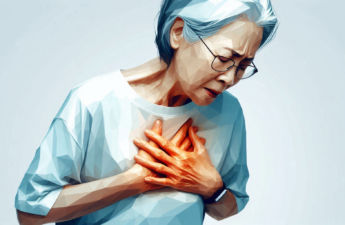From UW School of Medicine

Out-of-hospital cardiac arrests (OHCA) rose by 19% and survival of those events fell by about 4% during the first two years of the COVID-19 pandemic, according to an analysis of emergency medical services’ responses in Seattle and King County, Washington. But acute infections of the SARS-CoV-2 virus appeared not to be a primary cause of the changes.
In comparing EMS responses during the two years prepandemic (2018-19) against those during the pandemic in 2020-21, the investigators found data suggesting that indirect factors of COVID-19, such as slower response times by paramedics who needed to don more protective gear, and fewer cardiac arrests in public, had greater influence on OHCA incidence and survival.
The findings were published this month in JAMA Network Open. Jennifer Z. Liu, an epidemiologist with Public Health-Seattle & King County, was lead author. Several co-authors represented the Department of Emergency Medicine at the University of Washington School of Medicine.
“I was initially surprised at the low rate of acute COVID infections in our study population, because many research papers have pointed to a correlation between COVID and cardiac arrest. But once we looked at our data, it made sense that COVID infections played a small role [in increased OHCA incidence and lower survival],” Liu said.
The researchers counted 13,081 EMS responses to OHCA during the four-year span. Among the cases, 7,102 people were dead when first-responders arrived, and 5,979 patients received treatment. Among the treated patients, 19% survived until hospital discharge in the prepandemic period, in contrast with 15% during the pandemic span.
Available evidence indicated, however, that during the 2020-21 responses, only about 5% of these OHCA cases — whether treated or found dead on arrival — involved someone with acute SARS-CoV-2 infection, the investigators reported. Classification of people with SARS-CoV-2 infection was based on a positive test between 14 days before and seven days after the OHCA.
In discerning specific influential factors of OHCA incidence and survival, the researchers drew on data points from a validated model of predicting survival from sudden cardiac arrest, called the Utstein formula. King County maintains a registry of every OHCA response, aggregating Utstein-based data about each patient’s condition and circumstances of care — for instance, the interval between a dispatcher receiving a call and first-responders’ arrival on-scene, and whether the victim had a shockable heart rhythm upon EMS arrival.
The analysis of these data points suggested that a “constellation of behavioral and circumstantial challenges” created by COVID-19 affected the fates among people at risk of sudden cardiac arrest, said Dr. Thomas Rea, medical director for King County Emergency Medical Services and a UW professor of medicine.
“It took EMS longer to get to the patient because they were putting on PPE (personal protective equipment) — which we needed them to do,” Rea said. “Responders had to gown up for every cardiac-arrest response because we didn’t know which patients had COVID.”
With cardiac arrest, Rea said, the difference between life and death is measured in seconds.
“One minute is a meaningful addition to what is typically a speedy, highly coordinated resuscitation protocol. But gowning up was our public-health mandate.”
Rea also noted that, during the pandemic, many more cardiac arrests occurred in people’s homes than in public places, according to their analysis. The cardiac arrests that happened in public were witnessed by fewer bystanders, who in turn had less access to automated external defibrillators (AEDs) in facilities that normally would’ve been opened but were closed due to COVID-19.
Patient behavior likely played a role, too, Liu noted. As the pandemic emerged, King County 911 operators received fewer calls related to heart complaints, suggesting that patients were reluctant to address ominous symptoms for fear of acquiring the virus in a hospital emergency department, she said. Other research has documented that, in the pandemic’s first two years, many people with chronic conditions canceled clinic appointments for fear of contracting COVID-19 at a medical facility.
“The pandemic challenged multifaceted conventional cardiovascular prevention,” the authors wrote.
Liu said the findings might inform public-health responses during future pandemics and other emergencies.
“I think there’s an opportunity to improve the public’s awareness of how it’s important not to ignore symptoms or delay calling 911, because hospitals are equipped to handle infections and to mitigate exposures for patients,” she said.
The authors acknowledged that their findings of SARS-CoV-2 infections in OHCA cases might differ from those in other health systems, especially “systems with distinct COVID-19 epidemiology or EMS response.”
Also, the classification of people with SARS-CoV-2 infection was not based on comprehensive testing, so might represent an undercount, Liu said.


